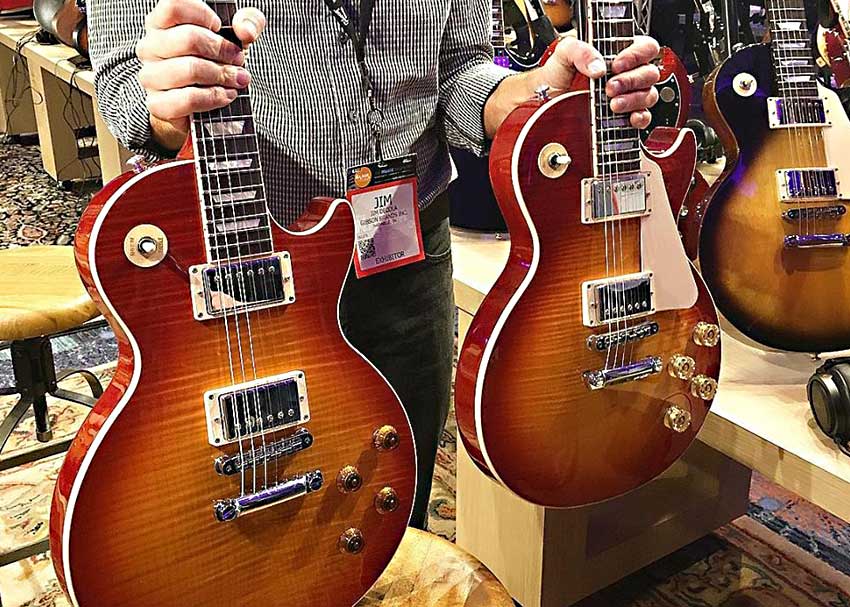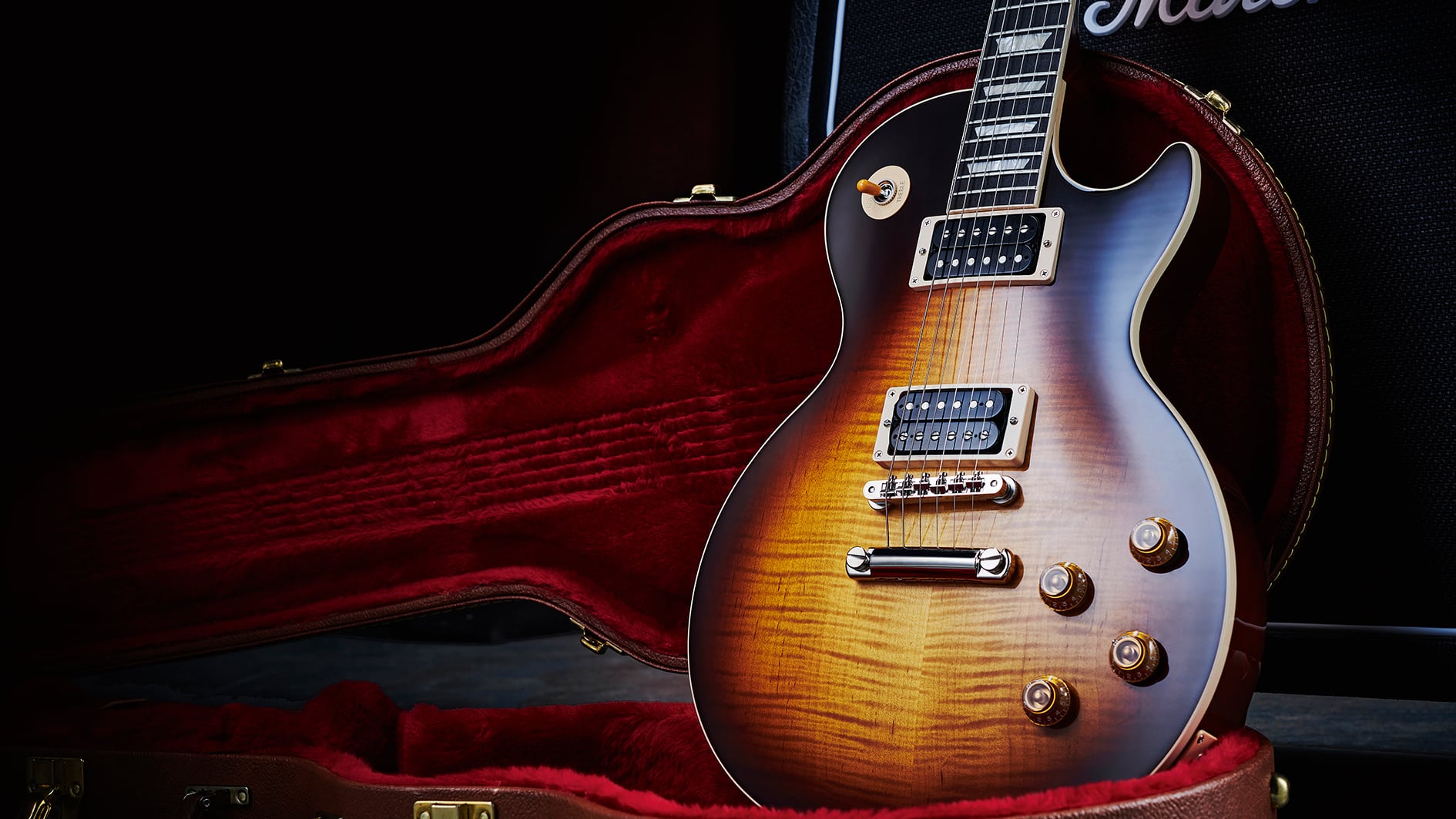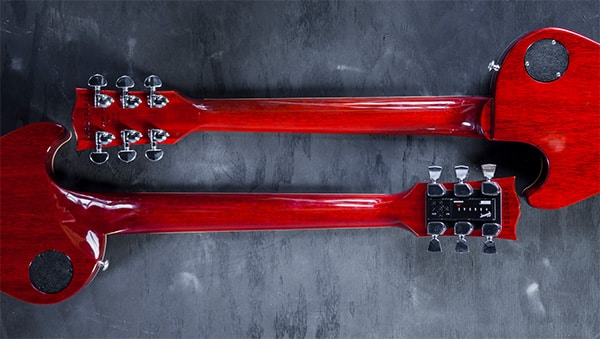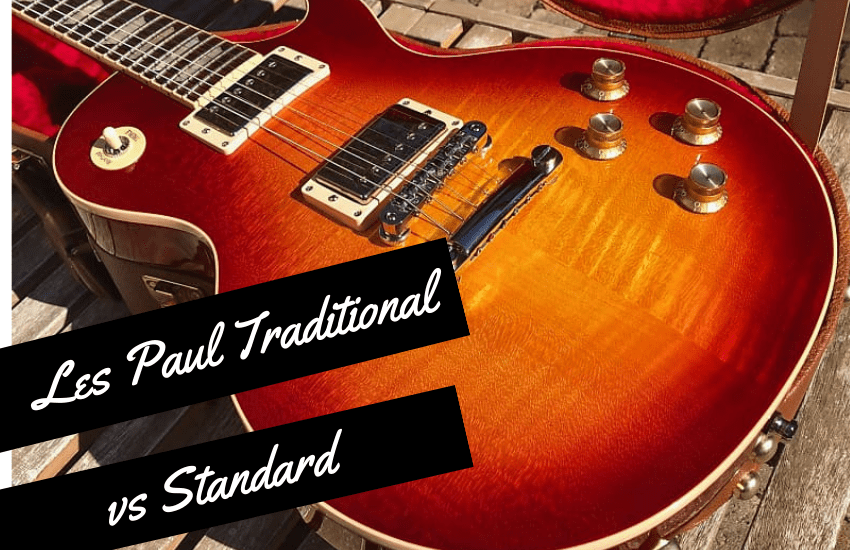Contents
Who doesn’t want to get a Gibson guitar? And, who doesn’t want to own a Gibson Les Paul. Such an iconic guitar, everyone wants to have one. Yet, the challenge now is to choose Gibson Les Paul Traditional vs Standard.
From the name of the guitar itself, it was Les Paul who designed this for Gibson. The Gibson Les Paul becomes the first solidbody electric guitar with great features that were never found in the existing guitars. It became an icon ever since.
Gibson Les Paul – Background
If you can trace back history, the Gibson Les Paul has evolved throughout the years. The first release of the Les Paul was in 1952, featuring a mahogany body and two (2) P-90 single-coil pickups. Then came the Les Paul Custom in 1953, a black guitar with gold-plated hardware. It has the famous Tune-o-matic bridge, and they got new pickups, the humbuckers in 1957.

Gibson Les Paul Standard came around 1958 which had a few major changes, although retaining some great aspects of its predecessors. In 1961, the traditional Les Paul models were phased out to give way to the more stunning models, the SG. However, shortly after, they started to produce the Standard models again, which has gained more popularity with Eric Clapton, Jimmy Page and other famous artists using it.
Over the years, Gibson Les Paul has been redesigned and to date, you can see popular variants like the ‘Standard,’ ‘Traditional,’ ‘Classic,’ ‘Special,’ and ‘Studio.’ Standard and Traditional versions are among the most interesting. So, this article will focus on unraveling the differences between the two and, which is perfect for you.
Gibson Les Paul Traditional
The Traditional Les Paul (or Trad, for short) models are the closest to the first few Les Pauls that were released during the 1950s to 1980s. If you want to achieve the classic Les Paul vibe, this is the guitar you need. The design, together with the mahogany body and maple top, give you the classic looks.
Not many bells and whistles, but it can guarantee you the fuller and beefier sound of Les Paul, like the late 50s.
Gibson Les Paul Standard
The Les Paul Standard, on the other hand, offers more modern stuff like the split-coil pickups for a wider range of sounds. It has more modern appointments and seems to have evolved through the years, conforming to the needs of new musicians.

Now, the Standard models have higher output pickups than the Trad. Hence, if you are in the look for a guitar that can accommodate the variety of genre you’re playing – jazz, rock, blues, pop, country – the Gibson Les Paul Standard is something you need to check.
Gibson Les Paul Traditional vs Standard: In-Depth Comparison
If you can’t get over the old and original sound of a Gibson Les Paul, the Traditional is what you’re looking for. Yet, if you want more versatility, then, it’s the Gibson Standard that you want. This is just one side of the story.
To help you lock in your choice, here’s an in-depth comparison of the two in terms of the design, pickups and sound difference, additional features, and the pricing. To get started, check out this table.
| Les Paul Traditional | Les Paul Standard | |
| Body Shape | Single cutaway | Single cutaway |
| Body Type | Solid body | Solid body |
| Neck Shape | Rounded | Slim Taper |
| Scale Length | 24.75″ | 24.75 in. |
| Fretboard Material | Rosewood | Rosewood |
| Fretboard Radius | Compound radius | 12 in. |
| Number of Frets | 22 modern frets | 22 medium jumbo frets |
| Pickups | HH; Underwound offset coil vintage-style with alnico V magnets (for the bridge and neck) | HH; BurstBucker 61R (neck) & BurstBucker 61T (bridge) |
| Controls | Volume controls: push/pull either splits the humbucker to single coil or taps the humbucker pickup
Rhythm tone control: push/pull phase switch Treble tone control: in single coil mode toggles between the inner and outer coils |
3-way pickup switch(Hand-wired with Orange Drop Capacitors); 2 volume and 2 tone controls |
| Hardware | Nashville bridge with aluminum tailpiece; Locking Grover tuning machines | ABR-1 fixed bridge with stopbar tailpiece and Grover Rotomatic tuning machines |
Neck Profile
The Trad Les Paul has a thicker neck profile, while the Standard has compound neck radius. This means, the fretboard of Les Paul Standard is curvier at the bottom (near the nut) and becoming flatter towards the neck.

Playability-wise, depends on your preference. Most guitarists claim that smaller radius makes fingering chords easier, while the flatter fretboard is perfect for solos. It’s better to play both guitars to know which one is perfect for you.
Sound Department
As mentioned in the introduction, Traditional Les Paul offers the classic sound of the original Les Paul – beefier and fuller, which was prevalent in the 1950s. This is, thanks to the pickups onboard in the Trad models.
For the Standard models, you will get more versatility. So, if you want to achieve the best contemporary sounds like pop, jazz, country and even metal, with the Burstbuckers onboard, you can do really well. In addition, this is also thanks to the internal DIP switch that offers more tonal options.
Pricing
None of the two can be called cheap, after all they’re Gibson Les Pauls. With all the bells and whistles of the Standard, it’s quite expensive compared to the Trads. Depending on which particular model you want, but, it’s usually the modern features of the Standard variant that add to the price.
Pros and Cons
Just to summarize everything about the Les Paul Traditional vs Standard, here’s a quick pros and cons.
Les Paul Traditional: Pros
- Cheaper with the same great quality
- Replicates the iconic Les Paul sound
Les Paul Traditional: Cons
- No weight relief, heavier
- Limited tonal options
Les Paul Standard: Pros
- Offers a wide range of tonality
- Features ultra-modern weight relief, it’s lighter
Les Paul Standard: Cons
- More expensive
Conclusion
You’ve reached the end of the Gibson Les Paul Traditional vs Standard comparison. Hope, by now, you have your bet. Again, base your decision on your preferences. Do you need a go-to electric guitar that you can play anytime, anywhere? You’ll need the Les Paul Standard.

On the other hand, if you always want to play like Les Paul and want to achieve the sound of the famous recordings of the 50s, the Les Paul Traditional is perfect for you. Whether it is the Standard or the Traditional, you’re holding in your hand a piece of history. Therefore, make a history with any of these Les Pauls.

Hi music fan! I am Jeff. Hope that you enjoy some stuff I shared here in my personal blog.
About myself, Currently I am in charging as Artist Manager/Music Supervisor at 72 Music Management. I did managed album to Grammy Award in 2017 with 7 Nominations from 2014-2020 and had the opportunities to work with : A.J. Croce, Blind Boys of Alabama, Bobby Rush, Dom Flemons, Dustbowl Revival, Sarah Grace
Governor of the Memphis Chapter of The Recording Academy is one of a award that I am lucky to achieved.
